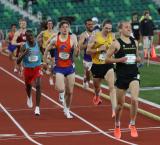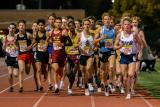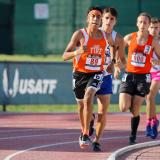Folders |
An Athlete's Perspective: Matt Wisner On Training And Racing At Hayward FieldPublished by
For Hayward Field, Track Is Back Editor's Note: Oregon distance runner Matt Wisner penned this piece about his first experience racing at Hayward Field for his Journalism class. Wisner spent four years at Duke and was an NCAA Indoor qualifier in the 800 meters before transferring to Oregon for his fifth year. His piece is re-printed here with his permission. By Matt Wisner Photo by Kim Spir I forgot what it felt like to race. The sound of the gun felt unfamiliar. It made me jump a little more than I remembered. I felt like my instincts were just a little dull, like I wasn’t quite as sharp as I had been. But that’s the nature of not racing in over a year. I came to Oregon for my fifth year — to try to go as fast as I can. I moved to Eugene last summer, and since then I’ve been training, waiting for the next race, which for a long time felt very distant. Hayward Field has also been in hibernation. Until last weekend, it had been nearly three years since a track meet was held here. In that time, hundreds of millions of dollars were spent on an enormous renovation project. Hayward has been completely transformed. The Oregon athletes began training in the new stadium in the fall. I’m one of those athletes. Many mornings Hayward feels eerie. In the late fall and through the winter, we’d meet there on cold mornings, a thick fog rolling into the stadium. There are about 20 of us, distance runners meeting for a morning run or workout. Hayward is massive, and to me, its natural state is this one: empty, quiet. The Hayward Premiere, which was held (April 2-3), showed me something different though. Nearly 20 other teams came to compete. There were fans in the stands, although the meet was operating at limited capacity because of COVID protocols. I’d never seen Hayward like this. This was the beginning of something new, both for me and for Hayward Field. As the start time for my heat of the 1,500 approached, the clerks shepherded us through a door on the side of the stadium, taking us through the indoor practice facilities to head out onto the track. I go in there every day. I know what it looks like. It’s a huge open room. It’s built so every event group can practice inside if they need to. But upon taking one step through the door, the other athletes in my heat were shocked. “What the f***,” one of them said. “Yeah, what the f***,” another responded. I’m usually very serious heading to the start line, but I couldn’t help but chuckle. The gun fired, and I headed straight to the front. I like to hover in second or third place on the outside of Lane One — let another athlete do the work and bide my time until it’s time to use my remaining energy on a fast finish. I was in my ideal position. About halfway through the race, this giant camera swung toward us almost violently, and I instinctively jumped out into Lane Two, just for a step. It’s better to run a bit extra than get my teeth knocked out. But of course I had overreacted. Close-up shots are standard here. I’d never had a camera in my face like that during a race. During the past four years at Duke, I raced on a lot of tracks that aren’t even in stadiums. They certainly didn’t have sophisticated camera operations. Maybe that’s just part of the new Hayward tradition: meticulous documentation and high-quality footage for the broadcasts. Heading into the halfway point, there were two Portland athletes in the front. One of them looked smooth, and the other was more raggedy. They surged and tried to pull ahead together, but I didn’t want to let anybody get away from me. I thought about the workouts I’d been doing on the same track for months, just latching onto my teammates and letting the momentum carry me forward. Hold on, hold on, hold on. I thought about my coach saying, “Don’t let a gap open up,” as he’d said to me many times before in workouts. As I moved up onto the shoulder of the leader, the raggedy athlete pulled way out, forcing me into Lane Two to avoid trouble. It turns out he was just pacing his teammate. It’s usually our team’s responsibility to set up pacers because we have so much depth, and we almost always have somebody willing to help their teammates at their own expense. We’re taught to think of the team, not merely ourselves. So finding out the Portland athlete was a pacer was a pleasant surprise. I hate being in the lead, doing the work myself. He absolved me of that responsibility. Now, I was right where I needed to be: on the shoulder of the leader. I felt in control. Still patient. If I’d learned anything over the past year, it was patience. All through the winter, I’d only been able to watch my teammates compete, and now my time was finally here. I didn’t want to make my move too early. I’ve always been confident in my close. If I’m even remotely near the lead with 200 meters to go, I always think I can win. Maybe every miler thinks that. I was right. I pulled away on the final straight and won the race. I looked up at the board and saw the time: 3:42.95. A new lifetime best. I clapped for myself, celebrated. I stuck my tongue out across the line, which I didn’t realize until I saw photos later. A bunch of the other Oregon athletes were in the stands right next to the finish line, and they cheered so loudly. I was unsure whether they cheered for me or for an Oregon victory, but it didn’t matter. I felt like I was a part of something, and I knew that I'd done the right thing by moving here. I kind of rushed off the track, the tiredness in my legs delayed because I was so excited. Some guy in the stands yelled at me to take a victory lap. I thought it was a joke. He repeated himself. Again, I thought it was a joke. I’d won my race and was proud of myself, but the invitational heat was yet to come. A set of generally faster, more impressive 1,500-meter runners wouldn’t step on the track for another hour. Why would I ever take a victory lap? Apparently, it’s tradition at Hayward Field to take a victory lap when you win a race, regardless of what that race is. I was still the new kid. I didn’t know the rules. Maybe I’d have known that if I’d ever finished Bowerman and the Men of Oregon as my coach had softly assigned. Even though the stadium is new, a lot of the old remains. For example, above the entrance to every section of stands are black and white posters of older Oregon athletes. Some of the photos are a hundred years old, grainy and blurred, like they’ve been uncovered from deep in somebody’s attic. It seems to me that many of my teammates hold an unspoken understanding that what they’re doing is part of something much more important and longer-lasting than their personal athletic careers. Until racing at Hayward for the first time, I viewed myself as separate from that tradition. Outside the stadium now, I jogged with my teammates through the dark. Sometimes the cool down jog after the race really hurts, but after running a PR, I was still carried by adrenaline, light on my feet. Two of my teammates had also won their races, and they revealed that they’d both taken their victory laps. Neither of them were new here. They clearly understood the rules in a way that I hadn’t. We continued through the darkness, and I now knew what I’d do if I ever won a race in Hayward again. Somehow my steps were even lighter than before. More news |








